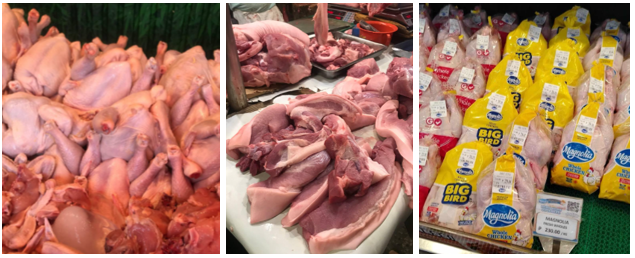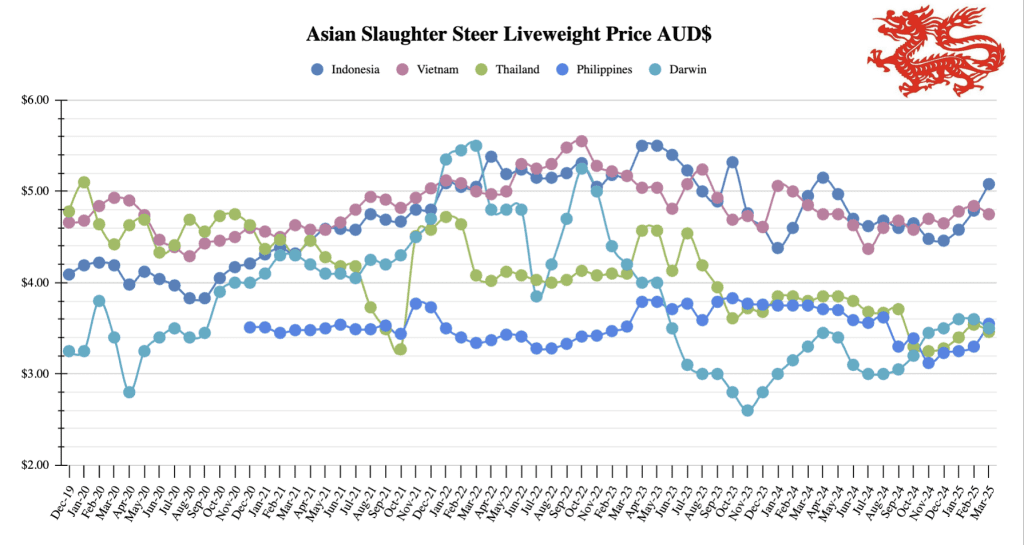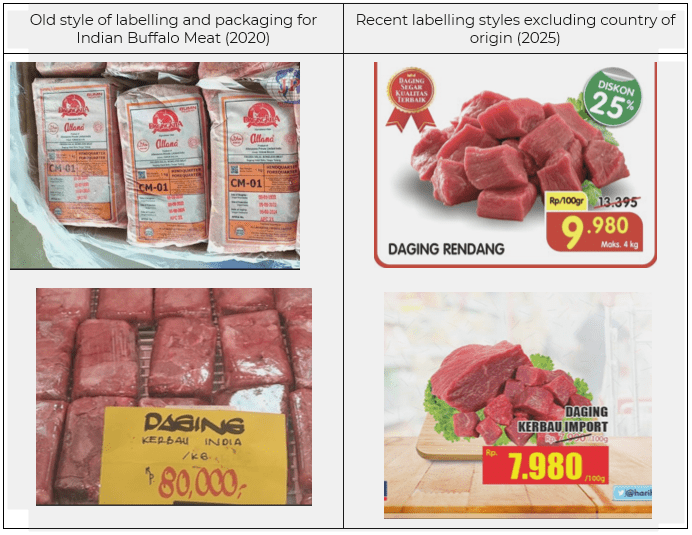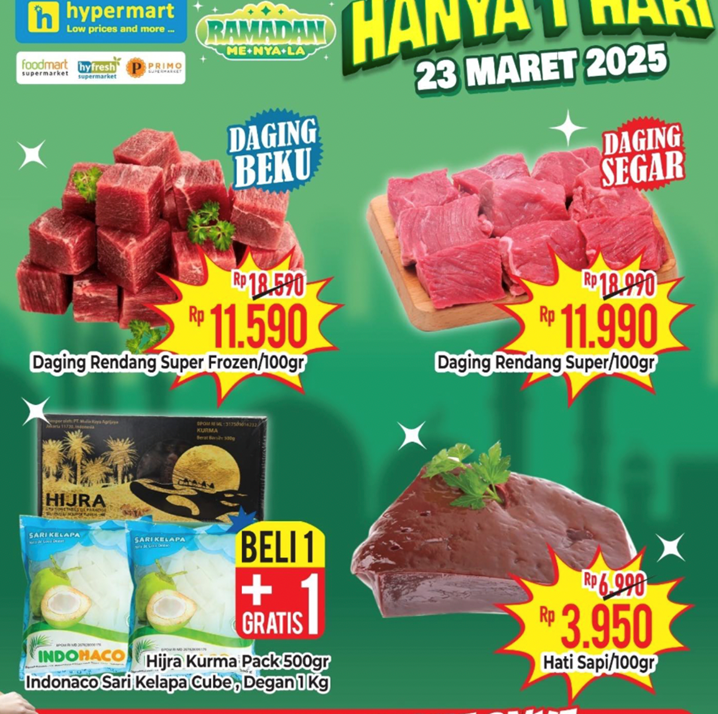
135th Edition: April 2025
Key points:
- Eid al-Fitr drives beef demand in Indonesia amid slow beef import progress and rising prices.
- Indonesia government is unlikely to realise it’s 200,000 head dairy cattle import goal.
- Philippines is set to approve commercial access to Vietnam’s African Swine Fever vaccine.
Indonesia: Slaughter Steers $5.08 AUD per kg live weight (IDR 10,340 = $1 AUD)
Beef Prices
Beef prices in local markets have increased with wet market beef knuckle priced at IDR 150,000 per kg ($14.51 AUD), while supermarket rates are the same with the previous month, at IDR 169,900 per kg ($16.43 AUD) at Farmers Market. Beef carcass prices have seen an increase, rising from IDR 98,000 per kg ($9.45 AUD) last month to IDR 107,000 per kg ($10.35 AUD). Slaughter steer prices increased slightly at IDR 52,500 per kg live weight ($5.08 AUD). Meanwhile, broiler chicken prices vary, with non-branded varieties selling for IDR 55,000 per kg ($5.32 AUD) at Pasar Modern Bintaro, while the branded option at Superindo is slightly lower at IDR 44,000 per kg ($4.26 AUD).
Eid al-Fitr Drives Peak Beef Demand Amid Import Delays
Indonesia’s Eid al-Fitr celebrations in early April brought the usual spike in demand for beef and buffalo meat, prompting a scramble by the government to stabilise prices and ensure sufficient supplies. While this period remains favourable for live cattle importers, with many cattle slaughtered at a premium, attention is already shifting to the more challenging Eid al-Adha in June, when local cattle are strongly preferred for ritual sacrifice due to religious and cultural considerations.
In preparation for Ramadan and Eid, state-owned enterprises (SOEs) PT Berdikari and PT Perusahaan Perdagangan Indonesia (PPI) were mandated to import 100,000 tonnes each of beef and buffalo meat. Yet, progress has been woefully slow, with Berdikari importing just 717 tonnes by mid-March and PPI reporting none. The National Food Agency (Bapanas) has issued warnings to both SOEs and private importers, threatening quota cuts if targets remain unmet.
After a contentious reshuffle in beef import quotas earlier this year, initially reducing private sector access before later restoring a portion, the market remains unsettled.
Labelling Transparency Under Scrutiny
Retail labelling practices are under growing scrutiny as many supermarkets increasingly market red meat using vague terms like “daging rendang” (rendang meat), without specifying whether the product is beef or buffalo. While chains like AEON, Lotte and Farmers Market still display origin details, most others have dropped clear labels for buffalo meat that were common in 2020 and 2021.
This shift comes as frozen Indian buffalo Meat is being sold at subsidised prices, with PT PPI offering it at Rp 75,000 per kilogram, compared to Rp 140,000 to 150,000 per kilogram for fresh beef in wet markets and over Rp 180,000 per kilogram for imported Australian beef in premium outlets. The lack of clarity has raised concerns among consumers, particularly during religious periods when meat origin matters. Online sellers on platforms like Tokopedia and Blibli offer more transparency, but inconsistencies remain.
Food Aid Through Post Offices
In a novel approach to food distribution, over 2,800 Indonesian post offices were repurposed to offer affordable staples, including frozen meat, at or below government-mandated ceiling prices. PT PPI, for example, sold frozen buffalo meat at Rp 75,000 per kilogram and cooking oil at Rp 14,700 per litre. While innovative, questions remain about the viability of such outlets for handling perishables like frozen meat.
Photos: Photo from Hypermart Banjar Baru
Dairy Ambitions: 200,000-Head Target by Year-End Not Realistic
Indonesia’s goal to import 200,000 dairy cattle by the end of 2025 is off to a slow start, with 3,000 head arriving from Australia and further imports planned from Brazil, Denmark, Vietnam, and the Netherlands. PT Asia Beef Indonesia (ABI) has committed to 20,000 Nelore cattle from Brazil, in partnership with the Ministry of Agriculture and East Sumba Regency. The initiative includes land allocation, farmer inclusion via plasma schemes, and a new 2,000-head quarantine facility set for 2026. The 2026 due date for the facility means that the Indonesian government is unlikely to get anywhere near to the 200,000 head of imported dairy cattle it was aiming for in 2025. It is expected that there will be further dairy shipments from Australia throughout the year though not anywhere near the magnitude required to hit the government’s target. There is continued chatter about ‘imminent’ Brazilian shipments but after several years of this rumour I am somewhat sceptical.
Australia Partnership Expands with “Kesehatan untuk Semua”
The Directorate General of Animal Husbandry and Animal Health, Ministry of Agriculture of the Republic of Indonesia, reported that Indonesia and Australia are strengthening cooperation in the livestock and animal health sector, focusing on biosecurity, human resource development, and innovative technologies. Agung Suganda, Director General at the Ministry, emphasized the partnership’s role in controlling animal diseases and supporting sustainable livestock production, including programs like Free Nutritious Meals (MBG). At a March 14, 2025 meeting with the Australian Department of Foreign Affairs and Trade (DFAT), led by Minister-Counsellor Tim Stapleton, Australia pledged continued support through knowledge sharing, capacity building, and research-driven initiatives. A key element is the “Health for All” program—an eight-year, A$100 million initiative set to launch in three Indonesian provinces and officially announced in May after the Australian election. “This partnership is part of an effort to support sustainable economic development in Indonesia, as well as improve safer and more efficient livestock and animal health systems,” Stapleton said. It comes on the heels of the concluded Red Meat and Cattle Partnership (RMCP) and may prove pivotal in supporting long-term animal health reforms.
Vietnam: Slaughter Steers $4.86 AUD per kg live weight (VND 16,040 = $1 AUD)
Cattle and Beef Prices
Slight drops in local prices across the board with imported Thai cattle are trading at $4.61 AUD/kg (74,000 VND/kg), cattle from Myanmar are at $4.86 AUD/kg (78,000 VND/kg) and local Vietnamese cattle are trading at $4.36 AUD/kg (70, 000 VND/kg). Imported Australian steers are holding steady at around $4.86 AUD/kg (78,000 VND/kg) and bulls slightly higher at $4.92 AUD/kg (79,000 VND/kg).
Wholesale prices for whole carcasses in abattoirs has not changed at around $10.91 AUD/kg (175,000 VND/kg). Retail beef prices are also flat at $11.84 – $14.34 AUD/kg (190,000 – 230,000 VND/kg).
Industry sources have reported that the high-tech beef processing plant recently built in Vinh Phuc Province is open but very inactive. Insiders report that the facility is currently processing small numbers of dairy bulls, far below its capacity numbers. The facility is owned as a JV between Vinamilk (large vertically integrated Vietnamese dairy company) and Sojitz (Japanese) with high ambitions for utilising and value adding their bull calves and for producing higher quality beef products locally and for export. The low numbers being processed is expected given it is still working out the market and internal capabilities. However past experience has shown that the margins for local processing can be difficult without high volumes and offtake of the entire carcass, and lack of export markets due to disease limitations on market access will always make this a challenge.
There has been more foreign investment interest in the Vietnamese industry recently with JBS Brazil announcing plans for a US $100 million investment two build two meat processing plants in Vietnam. The announcement was made during a state visit to Vietnam by Brazilian President Luiz Inácio Lula da Silva, along with the opening of the Vietnamese market to Brazilian meat. JBS participated as part of the accompanying business delegation. This is yet another sign of the substantial activity of Brazil to promote its beef and cattle in the region.
Philippines: Slaughter Steers $3.55 AUD per kg Live weight (P35.75 = $1 AUD)
Prices
Wet market prices for beef remain steady, with beef knuckle selling for ₱390/kg ($10.91 AUD), while supermarket prices sit higher at ₱450/kg ($12.59 AUD). Hot beef carcass continues to trade at ₱255/kg ($7.13 AUD). Slaughter steer prices are averaging ₱126/kg live weight ($3.52 AUD), based on recent listings for 12-month-old males weighing 275 kg.
In the pork sector, carcass prices hold at ₱220/kg ($6.15 AUD), and live pork is slightly higher at ₱166/kg ($4.64 AUD). Laman (lean pork cuts) in wet markets is fetching ₱350/kg ($9.79 AUD).
Broiler chicken prices have crept up modestly, with non-branded varieties retailing at ₱170/kg ($4.76 AUD) and the branded Magnolia product holding at ₱230/kg ($6.43 AUD).
Photos: Local meat and livestock sales in Mindanao
ASF Vaccine Set for April Approval
The Department of Agriculture (DA) is targeting early April for the commercial release of the ASF AVAC vaccine, developed in Vietnam, allowing farmers to source the vaccine themselves instead of relying on government programs. This next phase of the national recovery effort is expected to be a turning point for the beleaguered hog industry, with oversight from both the Food and Drug Administration (FDA) and the Bureau of Animal Industry (BAI). A separate government-controlled vaccination programme, already in motion, plans to administer 490,000 doses across selected areas.
ASF cases continue to trend downward, with just 68 affected farms nationwide in March, a dramatic fall from 534 recorded in October 2024. The province of Batangas has now declared itself ASF-free. These developments signal cautious optimism for a sector that has weathered years of severe disruption.
NDA to Launch Five New Dairy Stock Farms
The National Dairy Authority (NDA) has confirmed that five new dairy stock farms will become operational by April, part of its long-term strategy to increase national milk self-sufficiency. Located in Nueva Ecija, Bohol, Bukidnon, Cotabato, and Agusan del Sur, each facility will begin with 50 head of cattle, sourced from an upcoming shipment of 600 Australian dairy cattle.
The NDA is targeting 2.5% dairy self-sufficiency by the end of 2025, with ambitions to double that figure by 2028. With dairy imports continuing to dominate the Philippine market, this expansion marks a meaningful, if incremental, step toward reducing dependency.
Australia: Feeder Steers Darwin $3.50
Lots of cattle were coming out of western Queensland prior to the recent flooding with Darwin port seeing lots of livex activity through March. Early release of Indonesian import permits has seen plenty of interest to get the year started, with some activity to Vietnam as well. With large parts of Queensland affected by flooding and the impact on livestock, operators and roads the trend of high export numbers out of Darwin is likely to continue with cattle coming out of the Alice Springs region and western Queensland. A boat did load out of Townsville this week however, with another, the Greyman Express, waiting to load at time of writing.
The US tariff situation bodes well for the live export industry which was already eyeing off a strong 2025. Meat and Livestock Australia had cattle exports forecast at 803,000 head this year prior to the tariff announcement, with further growth in numbers expected out to 2027. If a solution is not found quickly it is hard to see the situation not putting some downward pressure on cattle markets this year which will only further assist live exports.
Year 2025 cattle exports – comparison across SE Asian markets





HAVE YOUR SAY